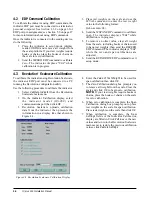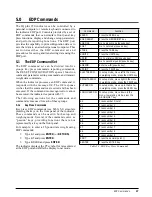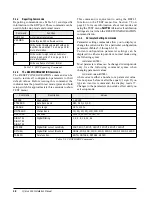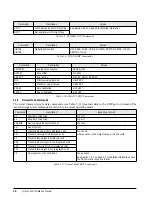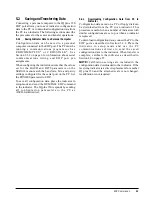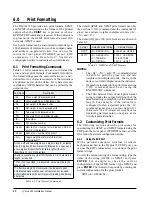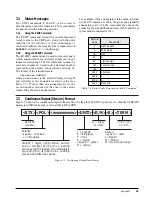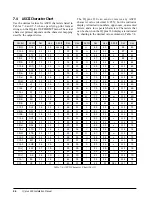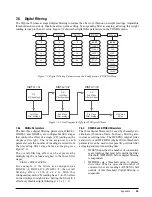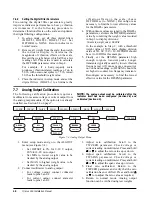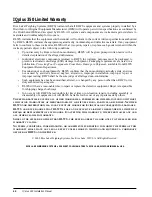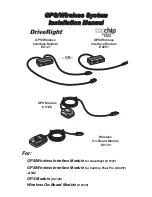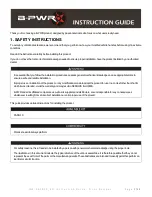
40
IQ plus 350 Installation Manual
7.6.3
Setting the Digital Filter Parameters
Fine-tuning the digital filter parameters greatly
improves indicator performance in heavy-vibration
environments. Use the following procedure to
determine vibration effects on the scale and optimize
the digital filtering configuration.
1. In setup mode, set all three digital filters
(DIGFL1, DIGFL2, DIGFL3) to 1. Set
DFTHRH to NONE. Return indicator to
normal mode.
2. Remove all weight from the scale, then watch
t h e i n d i c a t o r d i s p l a y t o d e t e r m i n e t h e
magnitude of vibration effects on the scale.
Record the weight below which all but a few
readings fall. This value is used to calculate
the DFTHRH parameter value in Step 4.
For example, if a heavy-capacity scale
produces vibration-related readings of up to
50 lb, with occasional spikes to 75 lb, record
50 lb as the threshold weight value.
3. Place the indicator in setup mode and set the
digital filters (DIGFLx) to eliminate the
v i b r a t i o n e ff e c t s o n t h e s c a l e . ( L e ave
DFTHRH set to NONE.) Reconfigure as
necessary to find the lowest effective values
for the DIGFLx parameters.
4. With optimum values assigned to the DIGFLx
parameters, calculate the DFTHRH parameter
value by converting the weight value recorded
in Step 2 to display divisions:
threshold_weight_value / DSPDIV
In the example in Step 2, with a threshold
weight value of 50 lb and a display division
value of 5D:
50 / 5D = 10.
DFTHRH should
be set to 10DD for this example.
5. Finally, set the DFSENS parameter high
enough to ignore transient peaks. Longer
transients (typically caused by lower vibration
frequencies) will cause more consecutive
out-of-band readings, so DFSENS should be
set higher to counter low frequency transients.
Reconfigure as necessary to find the lowest
effective value for the DFSENS parameter.
7.7
Analog Output Calibration
The following calibration procedure requires a
multimeter to measure voltage or current output from
the analog output module. If the option is not already
installed, see Section 2.4 on page 7.
NOTE:
The analog output must be calibrated
after
the
indicator itself has been configured (Section 3.0) and
calibrated (Section 4.0).
Figure 7-4. Analog Output Menu
1. Enter setup mode and go to the ALGOUT
•
Set OFFSET to 0% for 0–10 V output,
20% for 4–20 mA output
•
Set MIN to lowest weight value to be
tracked by the analog output
•
Set MAX to highest weight value to be
tracked by the analog output
2. Connect multimeter to analog output:
•
For voltage output, connect voltmeter
leads to pins 3 and 4
•
For current output, connect ammeter
leads to pins 1 and 2
3. Adjust zero calibration: Scroll to the
TWZERO parameter. Check voltage or
current reading on multimeter. Press and hold
or to adjust the zero value up or down.
4. Adjust span calibration: Scroll to the
TWSPAN parameter. Check voltage or
current reading on multimeter. Press and hold
or to adjust the span value up or down.
5. Final zero calibration: Return to the
TWZERO parameter and verify that the zero
calibration has not drifted. Press and hold
or to re-adjust the zero value as required.
6. Return to normal mode. Analog output
function can be verified using test weights.
XXXXXXX
XXXXXXX
VERS
ALGOUT
DIG IN
XXXXXXX
PROGRM
PFORMT
SERIAL
CALIBR
XXXXXXX
CONFIG
FORMAT
SOURCE
GROSS
0%
20%
OFFSET
ERRACT
FULLSC
HOLD
000000
number
MIN
10000
number
MAX
TWZERO
NET
TWSPAN
ZEROSC

